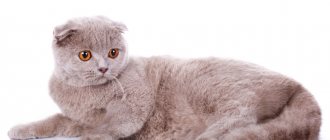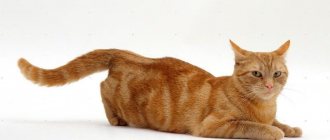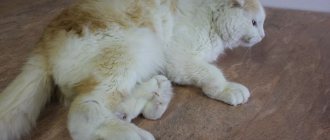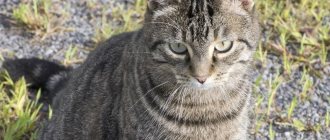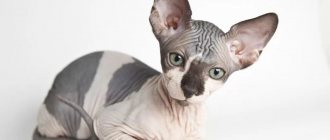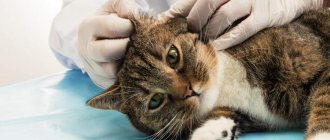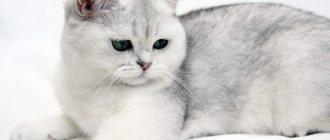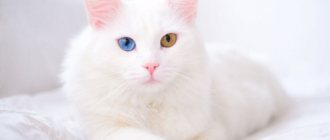There are three degrees of fold in Scottish cats of the Scottish Fold (short-haired fold cat) and Highland Fold (semi-long-haired fold cat) breeds. At first, all the kittens in the litter are straight-eared. Starting from the second or third week of life, the ears of Folds fall off. But at the same time, the degree of lop-eared folds in one litter may differ. The folds on the ears of a Scottish cat can vary in quality and quantity. And this will affect their price.
Today there are European and American types of Scottish cats. The European one looks more like a bear cub, because... During selection, large British cats were used. And American-type cats have better-fitting ears.
In the photo: 1 - ears fit perfectly, 2 - normal ear fit, slightly raised, 3 - helicopter ears (raised up a lot)
Degrees of lop ears in Scots: 1 fold
In the case of one fold, we can roughly say that the ears are folded in half, as if the fold is closer to the tip. As a result, the ears turn out to be raised above the contour of the head - and it no longer looks 100% spherical. With a very mild degree of lop ears, the ears even look not like they are slightly raised, but like they are slightly drooping. This effect is considered bad, since, according to the observations of breeders, most likely, such ears will subsequently stand up almost completely with a very high degree of probability.
One fold on the ear should cause the cat to become cheaper, because he risks joining the ranks of those with so-called helicopter ears, when they are neither this nor that.
Degrees of lop ears in Scots: 2 folds
With the second degree of lop ears, a double fold runs along its outer edge, as a result of which the ears are pressed more tightly to the head and, as a rule, do not spoil the spherical contour. However, it usually looks like a ball with some gaps between the ear and head.
If there are two folds, the ear can be pressed differently, because it also depends on the depth of these folds. The deeper they are, the more likely it is that the ears will not rise as the kitten grows.
Degrees of lop ears in Scots: 3 folds
The cherished number of folds on the ears of a Scottish cat is 3. The triple bend (fold) of the ears suggests that, in addition to the two folds that press the ears, such cats also have a third, which ran near the very tip of the ear, literally 3 millimeters from it. It is the third degree of lop-earedness that gives the cat the so-called baby face, when it seems that the entire muzzle is just huge round eyes, and there are no ears at all.
The third degree of lop-earedness is a real joy for the breeder, because such an animal has every chance of becoming the champion of more than one exhibition. Therefore, the breeder will either sell such a cat at a huge price, or will not even sell it, but will keep it for breeding and obtaining titles.
Do you know that?..
Sometimes the ears of folds rise completely and they begin to look like straights. Only an experienced cat breeder can distinguish a straight from an incorrect fold, who will see that the erect ears of a fold have a different shape and are smaller in size than the large ears of a straight. Inexperienced cat breeders often get confused and think that their cat is a Straight.
Scottish fold, which can be translated as “Scottish fold,” is the second name for the Scottish fold cat. This is a cute pet, a loyal friend and a real joy for all household members. The breed received this name because of its unusual ears, which do not stick up on the cats, but lie pressed to the head. In this article you will get acquainted with the description, character of these cats and the system of caring for them.
How to recognize a fold-eared kitten?
Even at a young age, animals have a number of distinctive features.
To acquire a real Scot whose ears do not stand up, the future owner should know the distinctive features of Scottish folds. If the kitten's ears are straightened, it will be a straight-eared straight. In addition, kittens whose ears do not straighten have a wide, round muzzle and fluffy cheeks. The chest is more developed, unlike those babies whose shells can stand up, the tail and limbs are thick and short. The transition from forehead to muzzle is smooth. A true Scottish Fold has a straight nose and no bumps or knots on the spine or tail.
In straight-eared Scottish cats, the ears are straightened and look larger, and there are no characteristic folds. In standard fold-eared Scots, the size of the outer part of the ear is small, and the degree of drooping of the ears is determined by the presence of characteristic kinks. This is a sign that the outer part of the organ will bend. The British differ from the Scottish in having small ears with a pronounced triangular shape, without folds.
History of the Scottish Fold
Scottish Highland farmer William Ross first discovered the Fold, which was widely discussed in felinological circles. He was interested in the strange shape of the animal’s ears, and later the farmer and his wife even founded the first fold-eared cattery in Europe, Denisla.
At first there were very few animals of this breed, so they were crossed with British outbred cats. But the offspring from such crossing were born with increasingly less droopy ears, for this reason it was decided to cross the Scots only with their own kind.
Official organizations that are engaged in the breeding of cats, such cats were recognized as a separate breed only 15 years after they learned about them. It is surprising that fold-eared cats were recognized as a separate breed not in the UK, but in the USA. Scottish Folds began to be registered at cat shows, and only a decade and a half later a unified standard of appearance for this breed was developed.
Over time, breeders had a new problem - kittens appeared with serious dysfunction of the musculoskeletal system. In the 1970s, the famous scientist from England L. Jackson established that such diseases arise from the genetic mutation Fold (genetic symbol Fd).
Did you know?
All Scottish cat kittens are born with straight ears and only by 5 weeks they acquire their characteristic shape.
The world organization GCCF, some time after receiving the research results, issued a ban on any work with Scottish Folds. But modern lovers of cats of this breed have nothing to fear, because in the same 70s, genetic scientists managed to breed three individuals of Scots in the United States.
Participation in the research of serious scientists made it possible to conduct a breeding program on cats of this breed. Research has made it possible to preserve the positive ear mutation and practically rid the breed of mutations in the musculoskeletal system.
Causes
The main difference between straight ears and drooping ears is the structure of the eardrum. Immediately after birth, kittens are similar to each other. Only after a while the ears either remain hanging and close the membrane, or rise. And sometimes this happens without any outside influence.
The straightening process is affected by:
- climatic conditions;
- stress;
- hormonal disbalance;
- diet;
- physiology.
If a fold-eared cat's ears are straightened, then weather conditions may have had a direct impact. For example, in the heat they straighten and stick out in different directions. A rare position occurs when bending backwards. In some cases, after climatic conditions normalize, a return to its original place occurs. This breed is characterized by excessive sensitivity and reaction to any changes in the weather.
This also happens if the animal is under stress. Often, owners noticed changes at times when the animal became nervous. In most cases, this position of the ears became permanent.
Often, a fold-eared cat's ears will rise after giving birth . Hormonal disruptions that occur in the body also affect lop ears. That is why many breeders participate with their pets at exhibitions only until the first birth, while the ears are hanging.
During the mating process, people sometimes take this process lightly and do not pay due attention to the main reason for straightening - genetic predisposition. If the gene responsible for lop-earedness is not fixed, then even if the kitten is born lop-eared, changes will soon occur.
Also, after incorrect mating and a thoughtless choice of a partner, kittens may not only change the structure of the auricle, but also develop a number of health problems. The consequence of such a mutation can be fusion of the vertebrae or problems with the musculoskeletal system.
You might be interested in: The cat has bumps all over its body: causes, consequences.
If a fold-eared cat's ears are straightened, then the reason may be in the animal's diet and the replacement of frequently consumed food with some other, less familiar food.
Selection criteria and kitten price
Choosing a Scottish Fold kitten is not such an easy task. Often, unscrupulous sellers try to deceive an inexperienced buyer regarding the price of a purebred Scottish yard kitten. Therefore, you should study the criteria for choosing an animal in advance.
First you need to know what class of kitten you need. There are such classes:
- PET class
- represented by kittens, which, despite their thoroughbred nature, have some deviations from the breed standards, therefore they are sold for castration in order to be just a pet in the future. The price of such kittens is from 75 to 270 US dollars. - BREED class
- kittens with good pedigree that meet breed standards; You can come to an agreement with the breeder about permission to obtain offspring from such an animal and participate in exhibitions. Kittens of this class cost from 225 to 600 US dollars. - SHOW class
are cats that ideally fit the breed standards; such babies are born quite rarely and are very valuable, since in the future they will participate in exhibitions and receive valuable prizes. Depending on the status of the parents, rarity of color and breeding line, prestigious class kittens can cost from 370 to 1000 US dollars.
Next, you should choose the color of your future pet, which, of course, depends on the color of the parents' coat. The Scottish Fold cat can have very different coat colors: from black to lilac (solid), with spotted or brindle patterns, and more rare colored, ticked, golden and others.
Choose a kitten only from trusted breeders or reputable nurseries. Take an animal that is at least 3-4 months old. Such kittens should already be vaccinated, and... A younger kitten will be less adapted to life without a mother, he will have a weak immune system, and it will also be quite difficult to accustom him to the litter box.
Did you know?
For the first time, a Scottish Fold cat appeared on the screens of the USSR in the cartoon
“
Carlson Is Back.”
This is a cat named Matilda, Freken Bock's favorite. Examine the pet's appearance - there should be no purulent discharge in the animal's eyes, they should be clean, and there should be no redness on the ears. The kitten's behavior is also important; an active and playful baby is good, a lethargic one is bad. Scottish Fold kittens should not be too thin when the spine is felt.
Osteochondrodystrophy in Scottish cats
We will talk about Scottish fold cats. The ancestor of the breed is considered to be a white country cat from Scotland, born in 1961. As a result of crossing with British Shorthairs, fold-eared kittens were obtained, which began to be presented at exhibitions. In 1966, the official registration of Scottish Fold cats began. In the process of breeding work, it turned out that when two lop-eared individuals mate, kittens are born with a disorder of the musculoskeletal system (fused vertebrae). A relationship was found between skeletal abnormalities and the Scottish fold mutation itself. In this regard, in 1971, further breeding work with this breed was prohibited in Great Britain.
Drop ears are also found in other animals, such as rabbits. This, as already mentioned, is the result of mutations. In fold-eared cats, the ears fall due to the fact that the cartilage has a fold. In domestic cats, this becomes visible when the kittens' ears become erect (around the fifth week of age). Often drooping ears are accompanied by abnormalities in other cartilages, but this may not be immediately noticeable. A genetically determined disease that causes a disorder in the development of cartilage and bone tissue is called osteochondrodystrophy (OCD).
The most pronounced symptom of this disease is usually deformation of the limbs. The hind legs are often shortened, the cat transfers its weight to the front legs, which are bent. Due to constant intense pain, the animal may move little, does not jump, and there may also be pronounced lameness or stiffness of gait. Additional signs of OCD may include:
- short, thick, rigid tail with a thin base
- enlarged head
- protruding teeth and crooked jaw
- bone growths in the heel bone
The disease itself often significantly reduces the animal’s quality of life, brings suffering to it, but does not pose a direct threat to life.
Since the signs of this disease are very typical, a preliminary diagnosis can be made based on a visual examination of the pet by a specialist. To make a final diagnosis, radiography is performed. The photographs usually clearly show changes in the structure of the limbs, spine and tail.
Today, the disease is considered incurable, but cats are prescribed supportive therapy that can improve their quality of life. In the initial stage of the disease, pain can be controlled with non-steroidal anti-inflammatory drugs. Chondroprotectors are also used, which help reduce cartilage degeneration and increase the amount of joint fluid. It is important to use balanced feed. It is also necessary to take into account the caloric content of the diet and regularly monitor the weight of the animal, because... excess weight puts additional stress on the skeleton.
So the question arises. If this disease cannot be cured, is it possible to somehow prevent it? In a litter of a fold-eared cat, some of the kittens will inherit fold-earedness, and some will remain with straight ears. Such cats are called Scottish Straight. They do not participate in exhibitions, but are necessary in the breeding of Scottish Folds. Mating of fold-eared cats with fold-eared cats is prohibited, because it threatens the appearance of sick offspring. A pair of straight and fold kittens are, as a rule, healthy, although cases of OCD are sometimes encountered (although this disease manifests itself later and in a milder form). Compliance with breeding recommendations is the only measure to prevent this disease, but is not a 100% guarantee of healthy offspring.
Conditions for a pet
Try to satisfy all the needs of your pet in the conditions of detention, since in any case he will find a way to satisfy them. If the cat jumps on the table and takes food from it, buy a tasty ready-made one and serve it only on the floor.
The Scottish Fold sharpens its claws on your sofa or wallpaper - let it until you buy him a scratching post (stand or board). If you want to wean your animal not to sleep in your bed, buy a house for your cat that is located higher up.
To improve the physical activity of your lop-eared friend, buy him toys, play with him yourself more often, take a laser pointer. An important thing in caring for a cat is the toilet. Buy a tall tray with absorbent filler.
If you bought a litter box trained kitten, there will be no unpleasant smell in your house. Some owners of pets of this breed manage to accustom them to the human toilet; this is not so difficult, since Scottish Folds are easy to train. However, if you plan to take your pet to shows, it is better to train him to the litter box.
Features of caring for the breed
The Scottish Fold cat does not require quite serious grooming or fancy feeding, which we will look at in the next section. Regular grooming of the animal's coat should be carried out 1 or 2 times a week by combing out dead hairs from the coat. However, your Scottish Fold is long-haired (regardless of color) - they will require more attention as their coat is prone to matting and will require brushing three times a week.
But a lot of earwax can form in their folded ears. Both long-haired and short-haired fold-eared cats need to clean their ears. As needed, but only with good quality shampoo.
Inner ear inflammation
Inflammation of the middle and inner ear often occurs together. In veterinary medicine there is no clear differentiation of these terms. However, with inflammation of the inner ear, not only the organs of hearing, but also the balance are involved in the pathological process. Clinically, this is manifested by impaired coordination (ataxia) and balance, “manege movements,” nystagmus, and deafness.
Deafness
Congenital deafness can be genetically inherited. Inner ear degeneration is often accompanied by blue eyes in pure white cats. In some cases, the influence of ototoxic substances or a viral infection can cause congenital deafness in a kitten.
This is interesting! Hereditary deafness is not always complete. Quite often, residual hearing ability is preserved.
Pathology of the vestibular apparatus
Clinical signs of congenital pathology of the vestibular apparatus appear between 3 and 12 weeks of age. Nystagmus does not always appear. Some kittens may be partially deaf.
Scottish Fold nutrition
A healthy and nutritious diet will make your pet of this breed energetic and cheerful. You can feed your cat either prepared food or cook your own food. Include the following foods in your animal's diet:
- containing a lot of protein and iron: these include beef, which is lightly boiled;
- chicken lungs, kidneys, heart (like beef), chicken or beef liver can be given once a week;
- sea fish. It should be low-fat and always boiled; in exceptional cases, you can cook river fish;
- fermented milk products with minimal fat content;
- porridge with milk or meat;
- boiled eggs.
During the active growth of your pet, if you feed him exclusively natural products, be sure to give him special vitamin complexes. Scottish Folds tend to be overweight
, because they love to eat, so it is necessary to regulate the animal’s diet in order to prevent overfeeding.
Important!
Eating only the same type of food can cause problems with the gastrointestinal tract.

